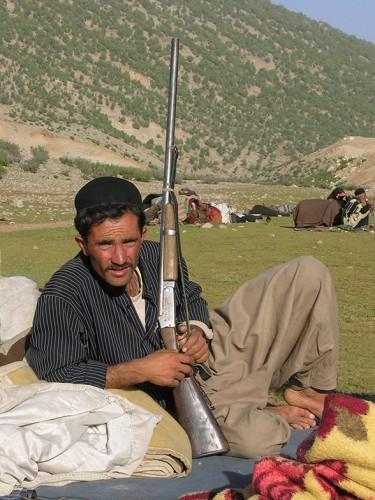
According to David Lockhart Lorimer, Bakhtiari poetry “reveals the real interests and outlook, and something of the experiences, of the Bakhtiari people”. He is clear that it is “the genuine product of the Bakhtiari mind” and that it owes nothing to any other poetic conventions.
Laments are the most common type of poem, with grief for the slain and admiration for valour in battle affecting the whole family or tribe, and “the most potent stimuli to poetic expression among the Bakhtiari”. Lorimer reports, however, that the more individual love poems are the most widely known, even if fewer are composed. In the historical poems, an intimate knowledge of tribal history and genealogy is assumed – names and relationships between people and places are never explained. I have included an historical poem, the events and participants of which we can trace from Henry Layard’s memoirs of his time spent living and fighting with the Bakhtiari in 1841.
According to Lorimer, Bakhtiari poets are not generally trying to set out the events of a story in a continuous intelligible narrative. Often, different people speak; but it is frequently impossible to divine who is speaking, or when the speaker changes. The language is commonly condensed to “a sort of telegraphese”; but there is also “a love of repetition and of playing with rhymes. The same couplet is repeated with a different rhyme and sometimes even a contradictory meaning. There is obviously more interest in the sound than in the sense”.

Lorimer explains how important it is to understand the natural world in which the Bakhtiari live: “many of the physical conditions and the common objects with which they come in contact in their daily life have acquired for them special sentimental associations and values, and this fact is made use of by their poets to awaken emotional memories”. For example, the chivil, or wild celery, is pushing up through the snow when the tribes reach the high mountains in spring. It is “poetically associated with the idea of grateful coolness after torrid heat” but is also used romantically as its “beauty, or perfume, can challenge the locks of the beloved, until the judge decides against it”. Much is made of climatic conditions, the terrain, and the various wild and domestic animals and birds. Almost every poem is packed with “impressive and sonorous” proper names. Although these are the “undoing of the uninformed”, they are “all familiar to [the poets] listeners, and many, especially place names, are charged with associations for them”.
In the battle pieces, attention is directed to the horse – “loved more than a brother” – and the arms of the warrior. The sword or rifle may have its own name, ‘Quli’, ‘Haji’, or “bear an honourable trade name, ‘Jaksan i Tajdr’, the ‘Jackson with the Crown’”.
Individual men may be described in terms of “his top-lock, which after his death may be rubbed with honey and given to his wife to keep as a memorial, and to weep over; his black or chestnut beard; his twisted moustache; his velvet locks; and crystal throat”.
The woman “of any man’s desire” may be “slender-waisted, tall of stature, bearing no child” or she may have “velvet tresses”. Lockhart says that “it is her ankles with the tattoo marks on them that chiefly excite the ardent lover. With greater intimacy, or more active imagination, he expatiates on her navel like the lake of Kauser, and her pomegranate nipples. Of external attributes it is her head-cloth, usually violet-coloured, that attracts attention. A silken headcloth, or silken trousers attest her superior birth. Her principal functions in life, rearing children and preparing food for the family, are recalled by the phrases ‘cradle-on-the-back’ and ‘knuckles in the dough’”.